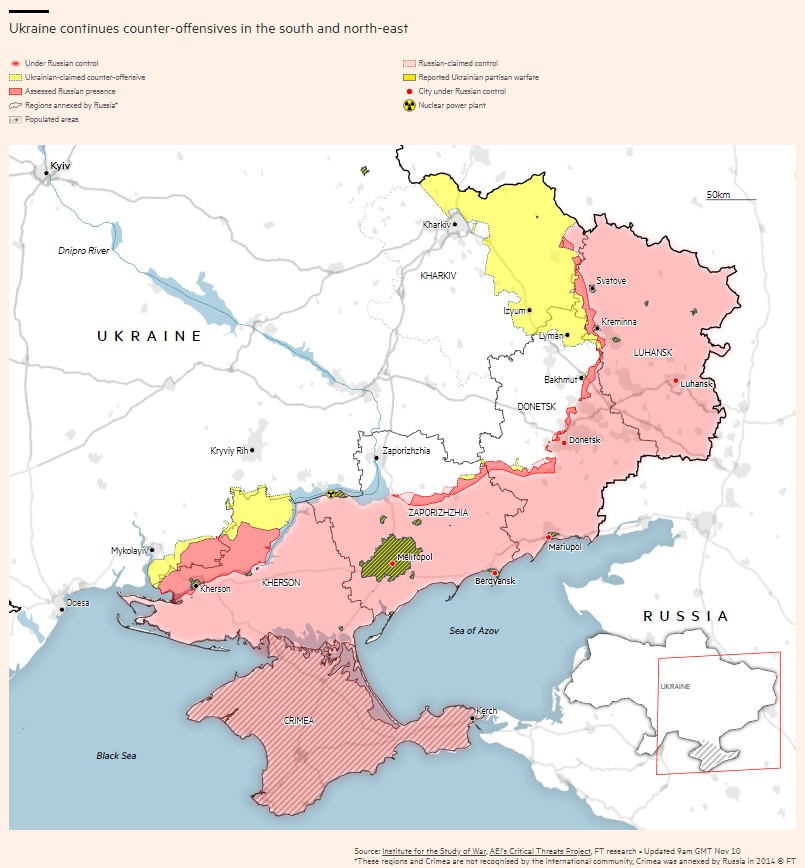On 09 November, Russian Defense Minister Sergey Shoygu ordered the withdrawal of Russian forces from the west bank of the Dnipro River in Kherson Oblast. The fighting retreat of Russian forces is meant to preserve manpower amid the looming routing of some of Russia’s best remaining units. Russia is no longer trying to suspend the Ukrainian counteroffensive, it is now trying to manage it.
Ukraine was able to achieve its goal of ousting the Russians from the side of the Dnipro without a major and costly ground offensive. Instead, the Ukrainian Armed Forces methodically targeted ammunition and logistical hubs, making it unviable for Russia to sustain and supply its forces on the western bank in Kherson City and its environs.
Russia still has 30,000 troops in the area and seeks to prevent a disorderly and costly withdrawal, similar to what happened in Kharkiv in early September. Withdrawal will take weeks with heavy fighting to be expected in Kherson City. Russian forces have destroyed multiple bridges, laid traps, and allegedly mined the Kakhovka hydroelectric power plant to delay advancing Ukrainian forces.
With winter rapidly approaching and with both natural and artificial defenses awaiting Ukrainian forces on the east bank of the Dnipro, the counteroffensive in Ukraine's southern Kherson will likely come to a close as the focal point of the conflict shifts east. All the while, Russia has 150,000-200,000 newly-mobilized troops training now that have yet to enter Ukraine.
ANALYSIS
- The planned withdrawal formally ends the prospect of Russia creating a land bridge that connects Transnistria, the pro-Moscow breakaway region of Moldova, to Russia proper. Not only was the land bridge supposed to promote territorial contiguity, connecting the pro-Russian populations in internationally recognized parts of neighboring nations (Transnistria, Crimea, Donetsk Peoples Republic, and Luhansk Peoples Republic), it also would have made Ukraine’s export-oriented economy reliant on Russia. Ultimately, the loss of western Kherson has dealt Russia a major strategic blow.
- With this territory back under Ukrainian control, Crimea, the most strategically and personally important Russian-occupied part of Ukraine to President Putin, will become vulnerable. Ukrainian forces will soon be able to target all the Russian ammunition depots and command and control centers between the Dnipro and Crimea and between Crimea and other Russian forces to the east.
- With the Kerch bridge, which connects Crimea to Russia, badly damaged, Ukraine is much closer to cutting off Crimea.
LOOKING AHEAD
- Russia's retreat will provide Ukraine an ample opportunity to inflict significant losses on Russia's best remaining units.
- Once Russian forces complete their withdrawal, half will be sent east to reinforce Russia’s other lines, further slowing down the pace of fighting.
- With winter nearing, Russia will continue focusing on entrenchment, as it awaits the arrival of 150,000-200,000 reinforcements.
- Russia will increase its use of Iranian-made "Kamakaze" drones and begin to use Iranian short-range ballistic missiles to continue the onslaught against Ukraine's electrical grid.
Support
Our team can respond immediately with the following capabilities:
- Bespoke intelligence reports and briefings
- Armed or unarmed security personnel
- Satellite communications (phone and wireless internet)
- Emergency medical and tele-medical support
- Logistical support
- Evacuation by ground where feasible
Click below to contact Global Guardian's 24/7 Operations Center or call us directly at +1 (703) 566-9463.





